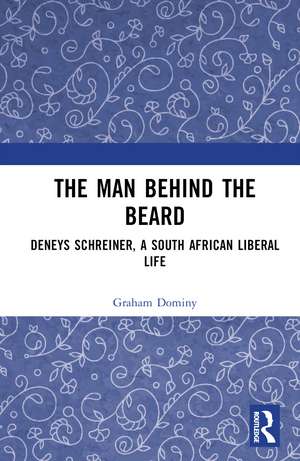The Man behind the Beard: Deneys Schreiner, a South African Liberal Life
Autor Graham Dominyen Limba Engleză Hardback – dec 2023
This biography sets out the context of the times in which Schreiner lived and his life from his ancestors to his tenure as Vice-Principal. This book is created with extensive archival research, supported by interviews with family members, former colleagues, friends, and journalists. Schreiner was a man who made a considerable contribution to the struggle for democracy in South Africa. And then there is the story of his beard, once described as a potent symbol of his presence and implacable integrity.
Print edition not for sale in Sub Saharan Africa.
Preț: 767.38 lei
Preț vechi: 1104.63 lei
-31% Nou
Puncte Express: 1151
Preț estimativ în valută:
146.84€ • 154.02$ • 122.24£
146.84€ • 154.02$ • 122.24£
Carte tipărită la comandă
Livrare economică 01-15 aprilie
Preluare comenzi: 021 569.72.76
Specificații
ISBN-13: 9781032633848
ISBN-10: 1032633840
Pagini: 256
Ilustrații: 40 Halftones, color
Dimensiuni: 152 x 229 mm
Greutate: 0.63 kg
Ediția:1
Editura: Taylor & Francis
Colecția Routledge
Locul publicării:Oxford, United Kingdom
ISBN-10: 1032633840
Pagini: 256
Ilustrații: 40 Halftones, color
Dimensiuni: 152 x 229 mm
Greutate: 0.63 kg
Ediția:1
Editura: Taylor & Francis
Colecția Routledge
Locul publicării:Oxford, United Kingdom
Public țintă
General and PostgraduateNotă biografică
Graham Dominy is Research Fellow in the Department of History at the University of South Africa. An archivist and heritage specialist, he was the National Archivist of South Africa for more than a decade. More recently, he worked at the Oman Across Ages Museum in Muscat as a Knowledge Centre and Collections Specialist.
Cuprins
Foreword by Blade Nzimande
Preface
Acknowledgements
Introduction: Almost to the Top of the ‘Greasy Pole’
1 Beginnings
2 From Boyhood to Battle via Wits (1923–42)
3 ‘Up North’: The Army and the Shaping of His Character (1943–5)
4 Science and Romance: The Cambridge Years (1945–51)
5 Research on a Cold War Campus: Pennsylvania State College (1951–2)
6 Launch into Liberalism and Academia: Johannesburg (1953–9)
7 Science Faculty and Family: Pietermaritzburg (1959–75)
8 Academy and Activism (1959–75)
9 Pietermaritzburg Vice Principal: Challenges and Tragedy (1976–87)
10 Vice Principal: Protests and Political Engagement (1976–80)
11 ‘Toughest One Yet for Prof Schreiner’: The Buthelezi Commission (1980–2)
12 Aftermath of the Buthelezi Commission Report: Deneys’s Predictions Fulfilled (1982–7)
13 Jennifer’s Trial and Retirement Years (1987–2008)
Conclusion: Drawing the Strands Together
Select Bibliography
Index
Preface
Acknowledgements
Introduction: Almost to the Top of the ‘Greasy Pole’
1 Beginnings
2 From Boyhood to Battle via Wits (1923–42)
3 ‘Up North’: The Army and the Shaping of His Character (1943–5)
4 Science and Romance: The Cambridge Years (1945–51)
5 Research on a Cold War Campus: Pennsylvania State College (1951–2)
6 Launch into Liberalism and Academia: Johannesburg (1953–9)
7 Science Faculty and Family: Pietermaritzburg (1959–75)
8 Academy and Activism (1959–75)
9 Pietermaritzburg Vice Principal: Challenges and Tragedy (1976–87)
10 Vice Principal: Protests and Political Engagement (1976–80)
11 ‘Toughest One Yet for Prof Schreiner’: The Buthelezi Commission (1980–2)
12 Aftermath of the Buthelezi Commission Report: Deneys’s Predictions Fulfilled (1982–7)
13 Jennifer’s Trial and Retirement Years (1987–2008)
Conclusion: Drawing the Strands Together
Select Bibliography
Index
Recenzii
‘An insightful historical account of the life and times of Deneys Schreiner. Not only should the story of Deneys be told because he belonged to the illustrious Schreiner family of social activists, but also because of his role at critical periods in the history of our country and his contribution to the inauguration of a democratic South Africa.’
— Blade Nzimande
— Blade Nzimande
Descriere
This biography sets out the context of the times in which Schreiner lived, and is created with extensive archival research, supported by interviews with family members, former colleagues, friends, and journalists.
